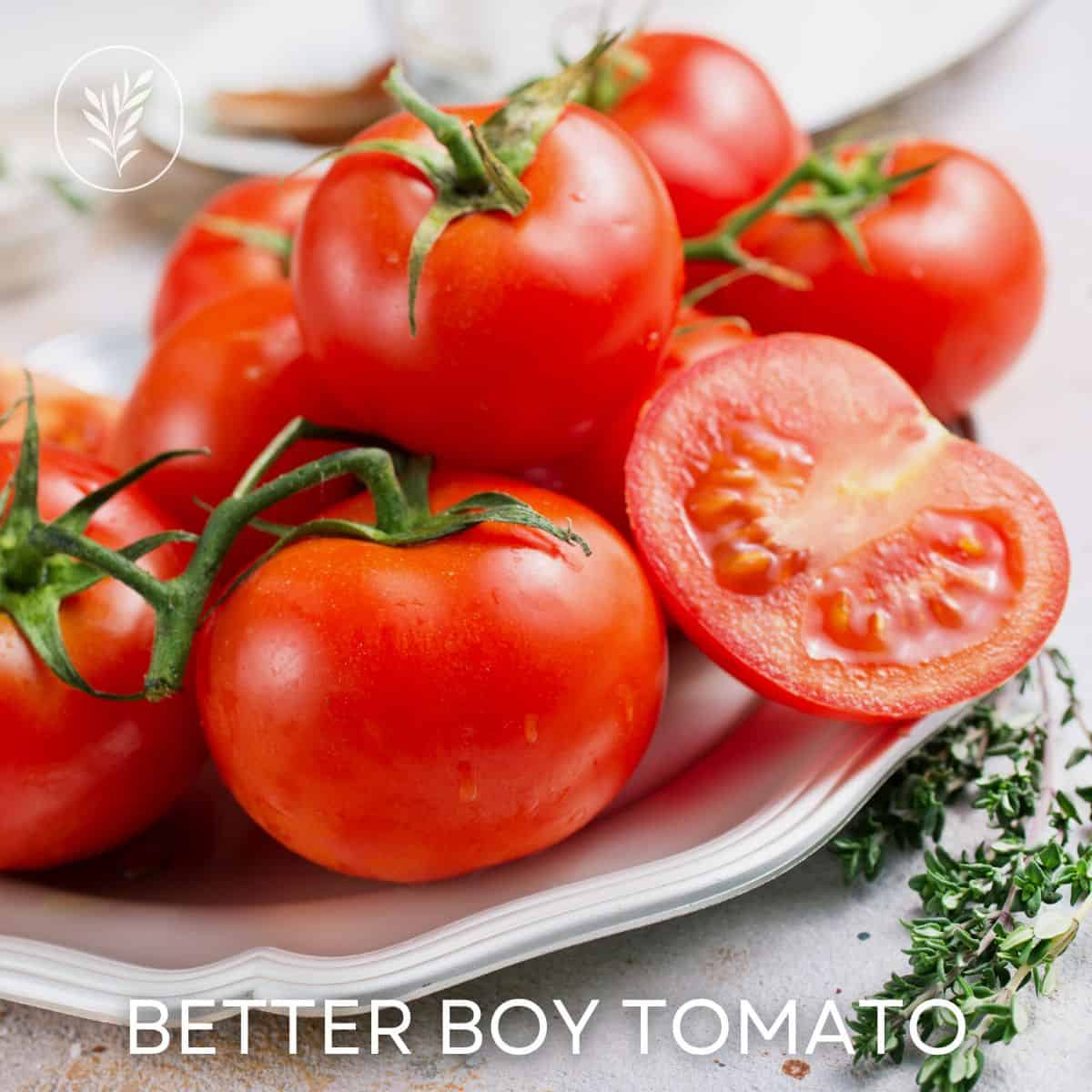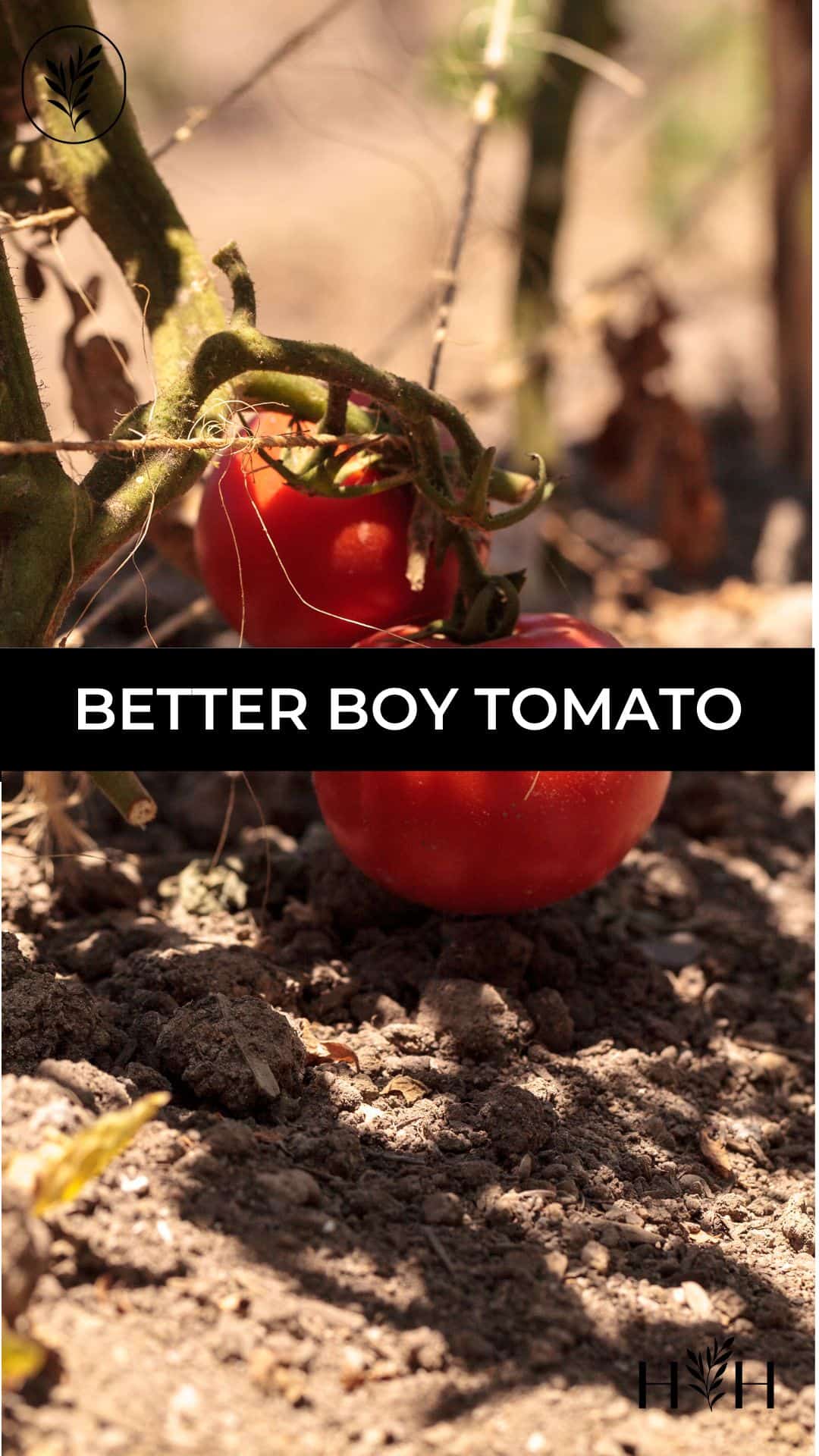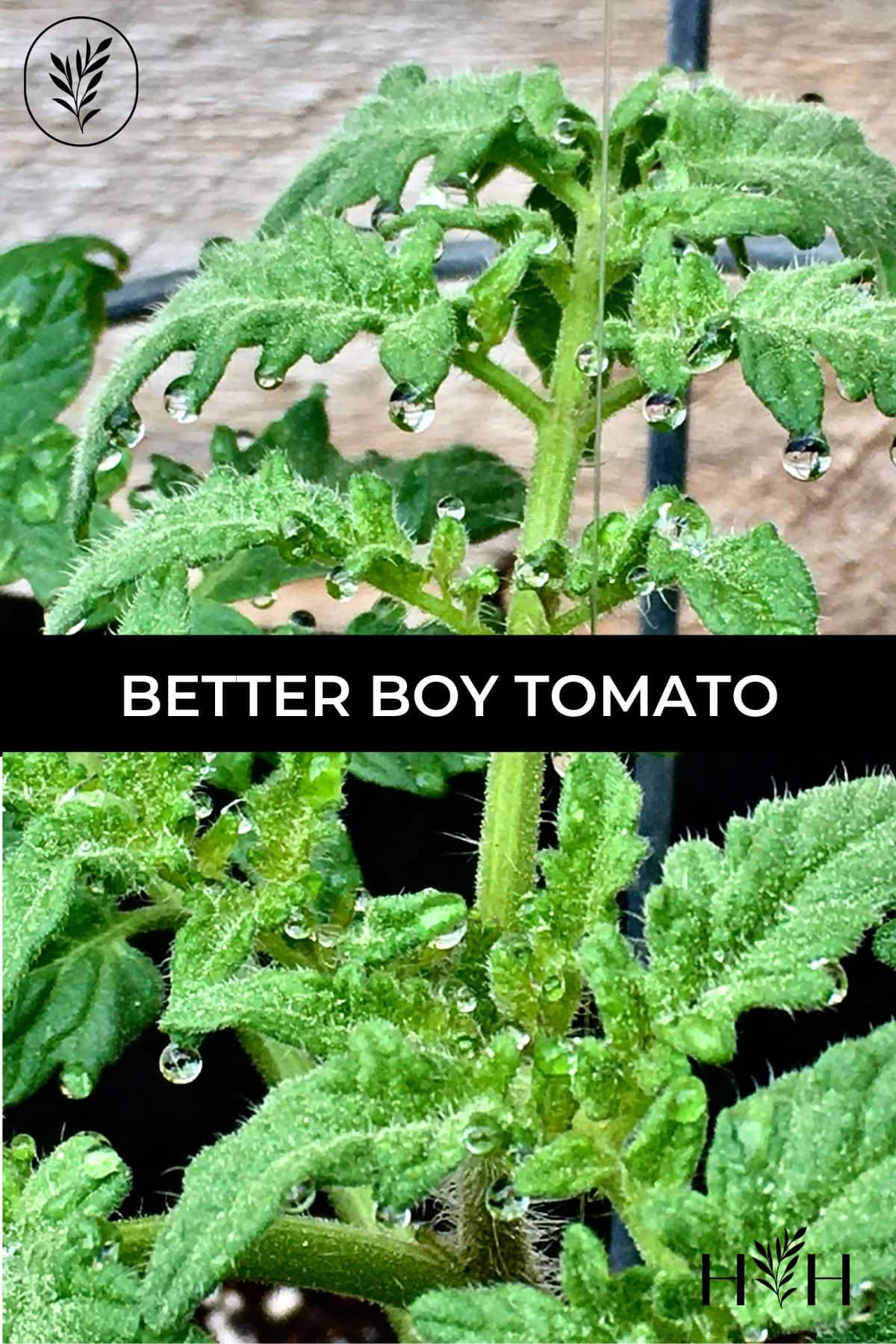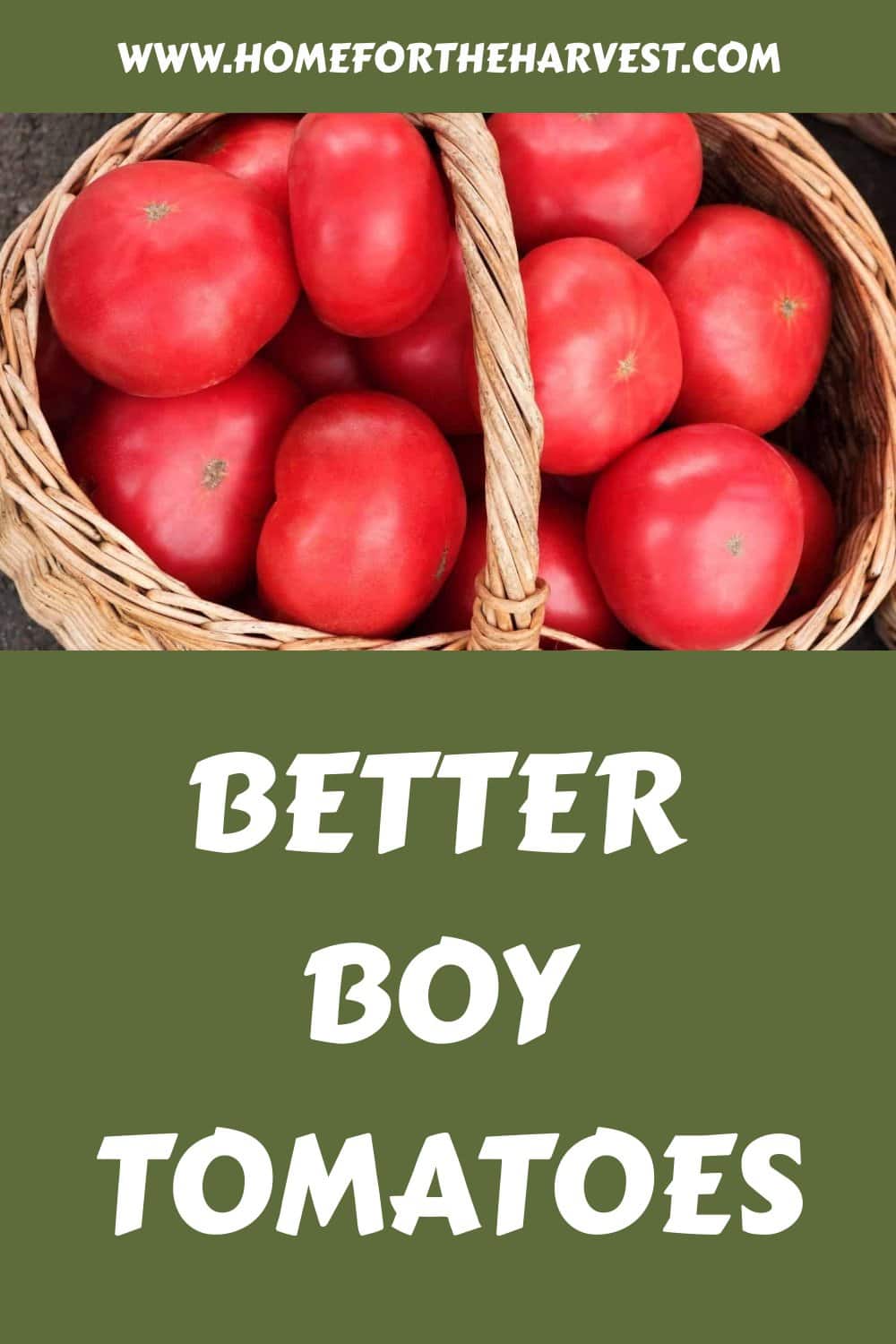The Better Boy Tomato is one of the most popular tomato varieties in the world. These big red tomatoes are a favorite for a reason!
The Better Boy Tomato is a very large, globe-shaped red slicer tomato cultivar with a classic tomato flavor. Better Boy is an improved version of the earlier Big Boy Tomato and is known for its increased resistance to disease in the garden and for its extremely high yields and reliable production. Developed in California in the 1960s, Better Boy is an indeterminate tomato plant that requires a tall tomato cage. This F1 hybrid tomato ripens in mid-late tomato season with the first tomatoes typically ripening about 72 days after seedlings are transplanted outdoors.
Read on to learn all about the famous Better Boy Tomato!
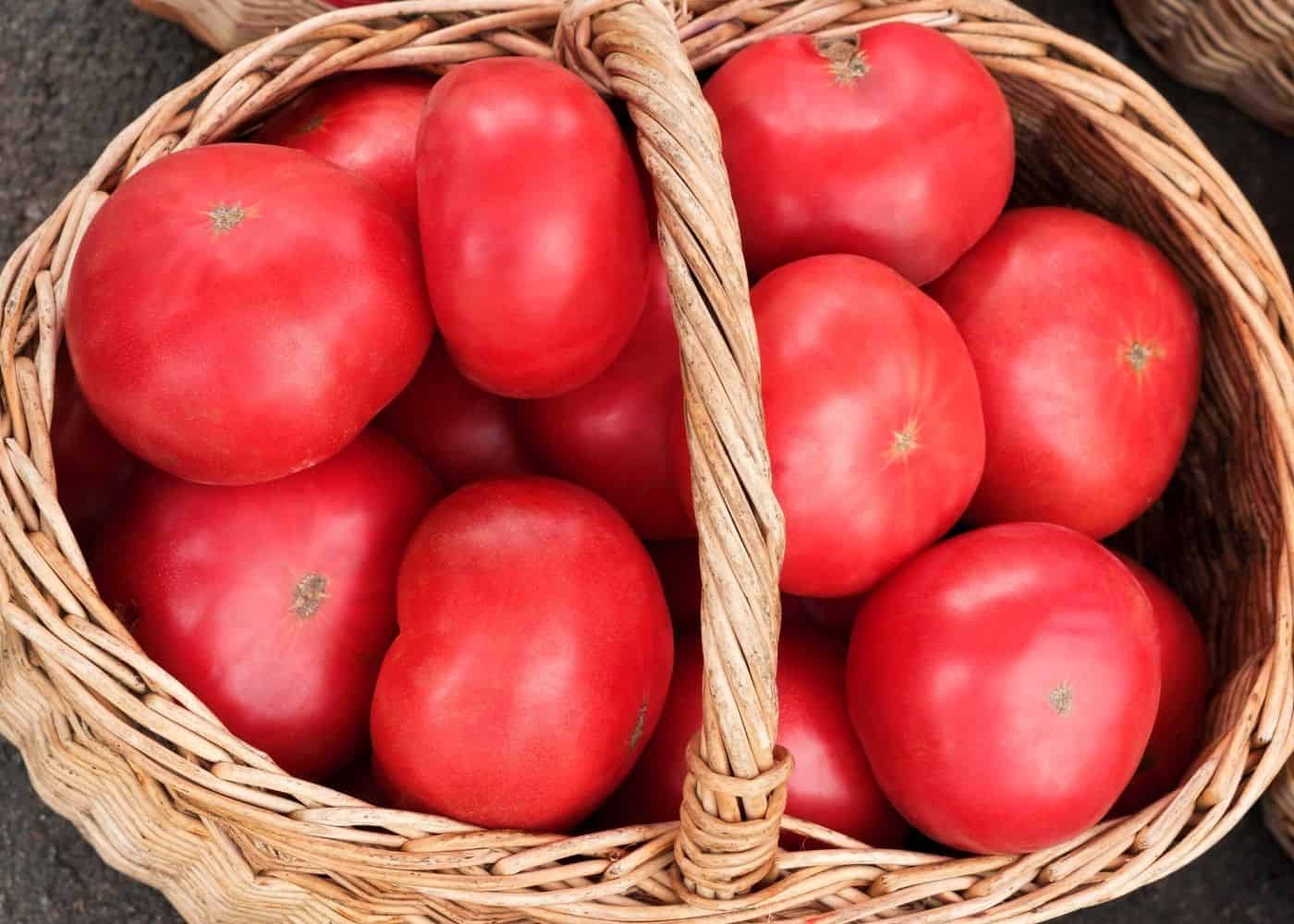
The Better Boy tomato
Better Boy Tomatoes are among the most popular tomato varieties due to their gorgeous red peel, very large size, and classic rounded shape. The classic tomato flavor has a nice balance between tart acidity and sugary sweetness, making this a great choice for home gardens. These slicer tomatoes are great in a fresh tomato sandwich, on a burger, sliced in a salad, or cooked in a fresh summer meal.
The Better Boy Tomato was developed by former Burpee breeder John Peto at his newly-formed seed company PetoSeed in Saticoy, California. This hybrid cultivar is thought to have been bred using ‘Teddy Jones’ and a proprietary large red tomato variety. John Peto bred Better Boy and introduced it in 1964 as an improved version of Burpee’s famous Big Boy Tomato. PetoSeed was a key supplier to Burpee Seeds until it was acquired by Seminis in 1995. Better Boy Tomatoes are one of the oldest hybrid tomatoes available and tend to have greater disease resistance and grow larger tomatoes than the original ‘Big Boy’.
The Better Boy Tomato is known for its high yields. A farmer named Charles Wilber from Cullman County, Alabama set a world record in the 1980s when four of his Better Boy vegetable plants produced 1,368 pounds of tomatoes in one season, with an average of 342 pounds per plant. You can read more about his tomato growing tips in his book, How to Grow World Record Tomatoes: A Guinness Champion Reveals His All-Organic Secrets.
A Better Boy plant is an indeterminate tomato variety. These herb plants grow vines that easily reach 8′-10′ long and must be supported by trellising to keep the vines from flopping on the ground. The best option is a heavy-duty tomato cage as discussed later on in this article, but these large plants can also be supported with a tomato stake.
Better Boy Tomatoes ripen mid-late in tomato season, with the first tomatoes ripening 70-75 days after the seedlings are transplanted into the outdoor garden. Harvest season for a Better Boy plant generally lasts about 10 weeks, with well-supported herb plants sometimes producing 30-50 massive tomatoes each. A Better Boy plant will tend to reach a weight of 12-16 ounces (up to 1 pound) each! These tomatoes are commonly as large as some of the best-tasting heirloom tomato varieties.
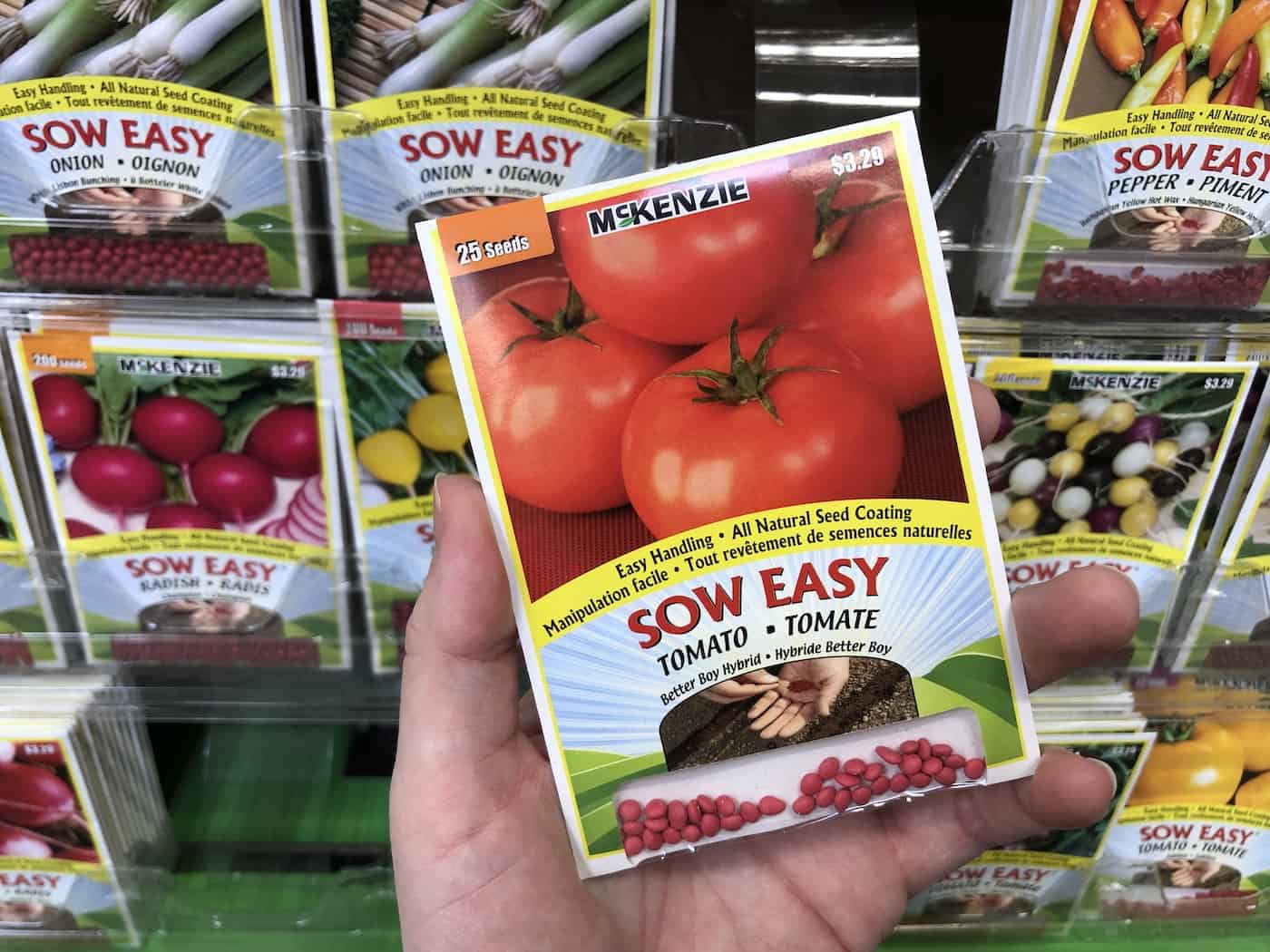
Better Boy seeds
“Better Boy: This hybrid is literally the son of the Big Boy variety and was developed with more disease resistance than the father plant. This is a very popular cultivar and is a standard in many home gardens. It is indeterminate and grows into a sprawling plant that will need strong support and some pruning.”
The Complete Guide to Growing Tomatoes: Everything You Need to Know Explained Simply, by Cherie Everhart
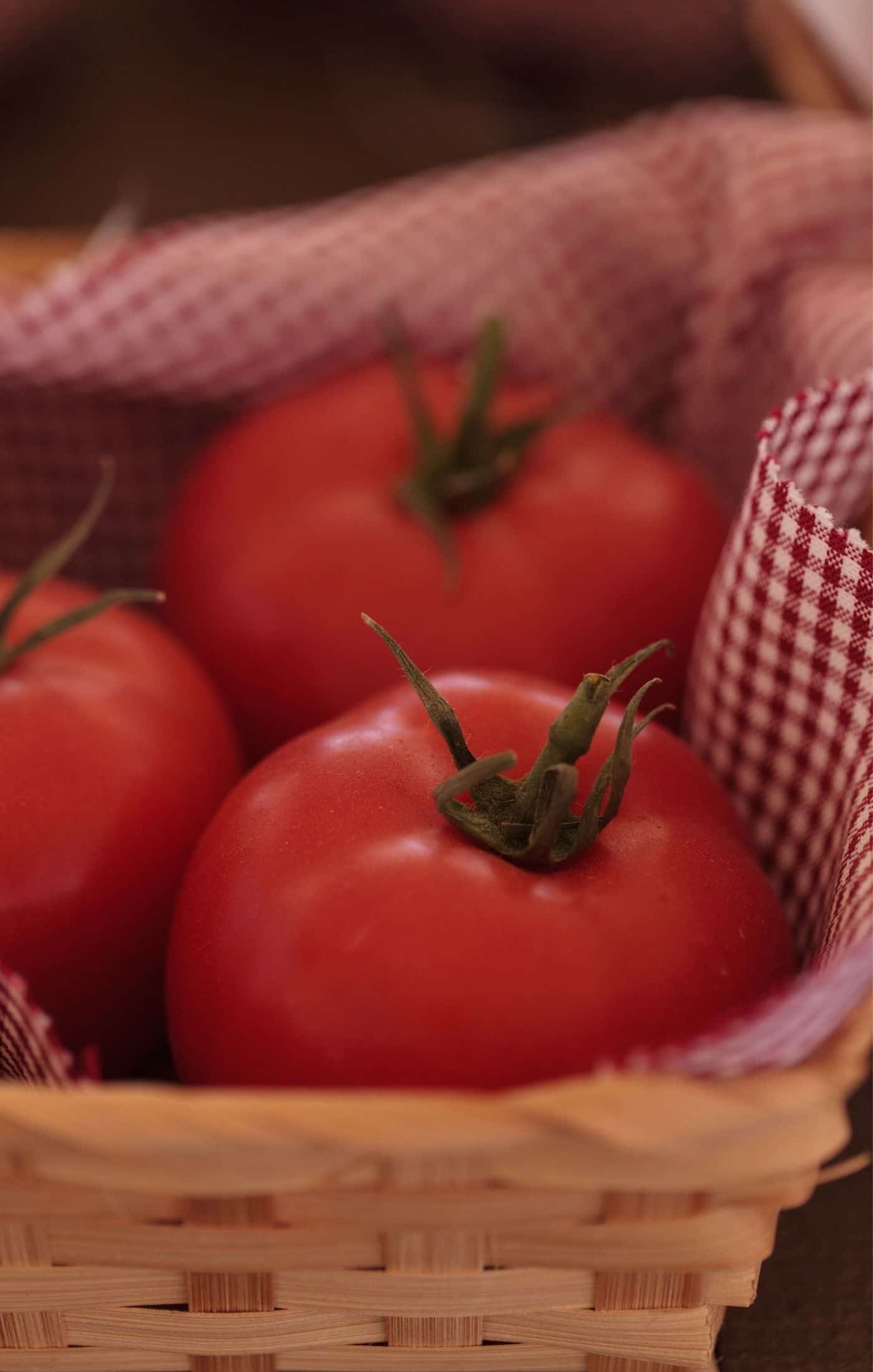
What do Better Boy tomatoes taste like?
Better Boy Tomatoes have a rich, classic tomato flavor with a balanced profile of tangy acidity and pleasant sweetness. These are meaty red tomatoes with a delicious aroma when picked ripe off the vine. While they might not have the complexity of flavor of some heirlooms like Brandywine, they are much more reliable producers in terms of the number of tomatoes harvested.
Better Boy Tomatoes typically weigh about 12-16 ounces each (340-450 g). There is usually only 1 Better Boy tomato in a pound. Better Boy Tomatoes are among the largest tomato varieties, reaching sizes similar to big heirlooms like Mortgage Lifter, German Johnson, and Green Giant.
How to grow Better Boy tomatoes from seed?
Better Boy Tomatoes are relatively easy to grow from seed. That said, it does require quite a bit of space and gear, so many gardeners opt to purchase Better Boy seedling plants from the garden center. If you’re starting with seedlings, skip to the next section.
Better Boy seeds are usually planted indoors 6-8 weeks before the local last frost date in your area. You can find your local date with this Frost Date Calculator. This timing generally translates to seeds being sown indoors in February-April, depending on the climate.
Supplies for planting Better Boy tomato seeds
- Better Boy Tomato Seeds:
- Organic Seedling Potting Mix
- Seedling Tray
- Floral Snips
- Dibber (optional)
- Seedling Heating Mat
- Seedling Plant Light:
- Seedling Watering Nozzle or Spray Bottle:
1. Plant tomato seeds
Fill the seedling tray up with potting soil so the mix goes into all the cells. Then water the whole tray to help the potting mix settle. Add a little more soil if necessary. The seed starting soil mix should be about a half inch from the top of each cell. Keep the soil moist for ideal planting.
Using a seed dibber or your fingertip, carefully sow the seeds about a ¼ inch deep in the seed starting mix. Most gardeners put 2-3 seeds in each cell, but if you don’t have many seeds, just place one per cell. Once the seeds are in the soil, brush a little bit of potting mix over them. Give the seedling tray one more gentle watering and allow all the excess water to drain out of the seedling tray. Pour out any water that has been collected in the bottom pan tray.
2. Add heat & light
Place the seedling tray on a flat stable indoor surface on top of the seedling heating mat. Tomato seeds germinate best at soil temperatures in the range of 75°-90°F (24°-32°C). In this soil temperature range, the seeds should germinate in about 6 days (source: University of California).
The seedlings will also need supplemental light to thrive when grown indoors. Position a plant light over the seedling tray. If possible, add a pulley system to raise the LED lights so you can keep them about 4″ above the seedlings as they grow (or whatever distance your specific lighting system recommends). Most gardeners leave the plant lights on for 16 hours during the day and then turn them off for 8 hours overnight. Most plant lights have an automated timer built-in.
3. Water & thin seedlings
Water the seedling tray regularly using a very gentle watering can or even a spray bottle full of clean water. Once the seedlings have emerged and are an inch or two tall, you can start bottom watering the seedlings by filling up the bottom pan tray with a bit of water and allowing it to passively wick up through the potting mix to reach the roots of the seedling plants.
Choose the strongest seedling in each cell and remove the others. If you seeded 2-3 seeds per cell, most cells will have 2 seedlings in them. Wait until the seedlings have their first pair of serrated “true” leaves prior to deciding which one is the strongest. Look for the seedling with the thickest, straightest stem. This is the one to keep. Using clean floral snips, trim the other (weaker) seedling off at its base, as close to the soil line as possible. Take care not to damage the seedling you’re keeping.
4. Pot seedlings up in larger containers
Once the seedlings become about 3x taller than the seedling tray and have about 3 pairs of proper serrated “true” leaves, it’s time to think about transplanting them into larger containers. You can use a seedling tray with larger cells or plant each seedling into its own individual 4″ wide pot. Most tomato seedlings have to be up-potted at least once prior to going outdoors as it’s still too cold in most climates for the tomato plants to go outside.
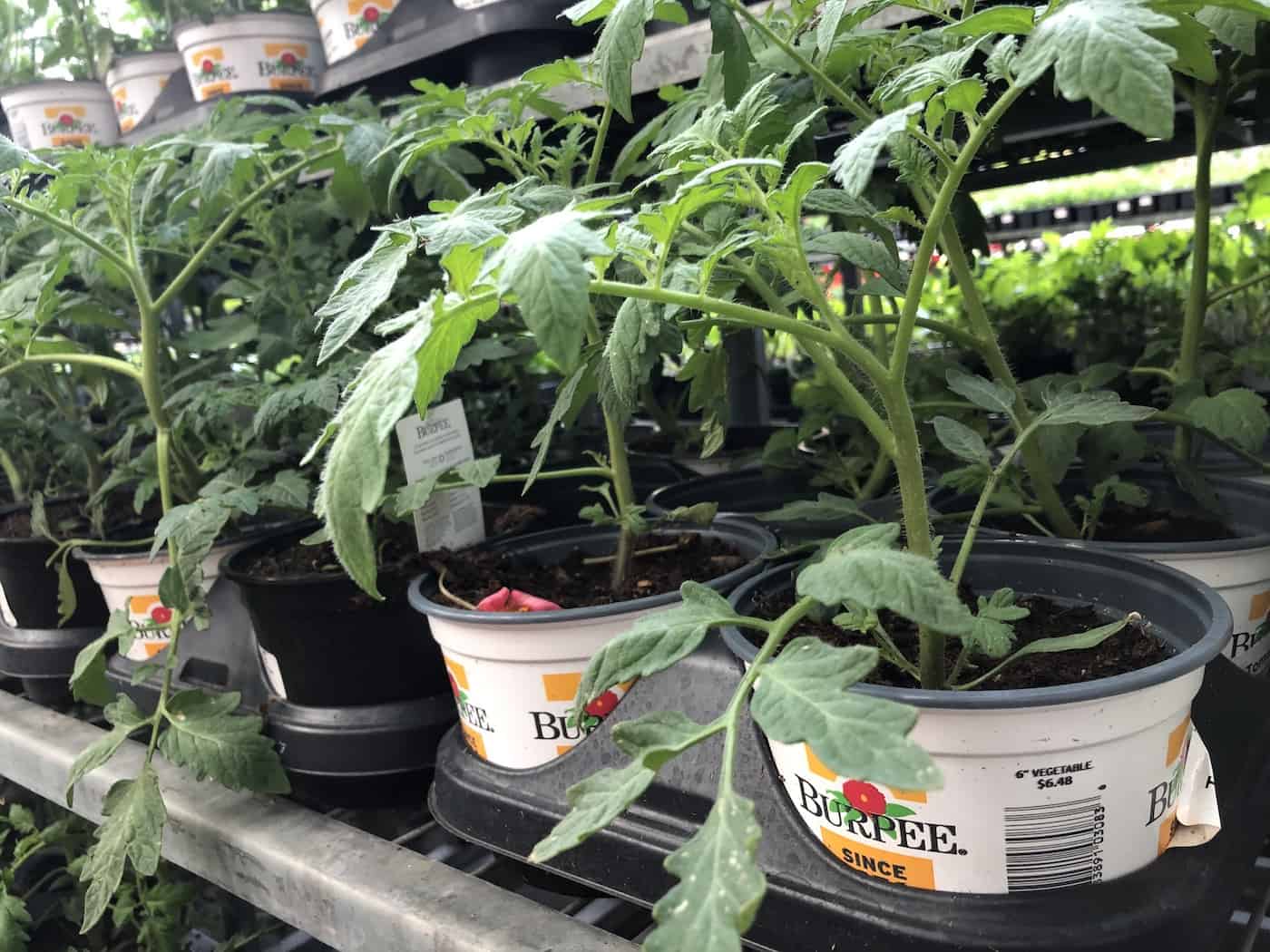
How to plant Better Boy tomato seedlings outdoors?
Better Boy Tomato Seedlings can be planted outdoors in the ground or they can be grown in raised garden beds or large container planter pots. For container growing, use a 10-gallon container at minimum. Large grow bags or half whiskey barrels are excellent. In containers, use a lightweight mix with a base of coco coir and/or peat moss plus some perlite to add air into the soil matrix. The best natural soil for these plants is a sandy loam that drains out excess water easily.
Better Boy Tomato plants are large plants that require a full sun planting location with plenty of space. This means at least 6-8 hours of direct sunlight should hit the leaves of the plant each day. This will help stop the leaves from turning yellow. You’ll also need room for a heavy-duty tomato cage and close access to a water source or automated drip irrigation.
Tomato plants are generally kept indoors until nighttime temperature lows are above 50°F (10°C). These tender plants can be permanently damaged at temperatures below 43°F (6°C). Resist the urge to plant them outdoors too early in cool soil, as it can stunt the plants and inhibit the growth of the roots. The result of this is often plants that grow slowly, do not yield well, and are susceptible to common tomato diseases and conditions like Blossom End Rot due to their underdeveloped roots.
Supplies for planting Better Boy tomato seedlings
- Better Boy Seedling Tomato Plant
- Handheld Garden Cultivator
- Slow-Release Organic Tomato Fertilizer
- Outdoor Watering System
- Plant Label
- Organic Compost
- Heavy-Duty Tomato Cage
1. Harden off the tomato seedlings
Tomato seedlings are “hardened off” in the spring to reduce transplant shock. This is done by slowly exposing them to outdoor conditions over a period of about a week. Once temperatures are above 50°F (10°C), start taking the seedlings outdoors for a few hours a day. Place the seedlings in a sheltered area protected from wind and direct sunlight and be sure to bring them in at night. As the week progresses, leave them outdoors for longer periods each day and start to introduce them to direct sunlight and a bit of wind.
2. Prepare the garden bed
Prepare the garden bed prior to planting the seedlings. Start by removing any dead plant debris from previous seasons. Next, work a slow-release granular fertilizer into the top 6″ of the soil. Then rake the surface flat with a handheld cultivator. Lastly, water the entire bed thoroughly and deeply to saturate the soil.
3. Plant the tomato seedlings
Remove the bottom leaves from the seedlings. Tomatoes are one of the specific plants that do best when planted deeper than their original soil line. Depending upon the height of the seedling, remove 1-3 pairs of leaves from the bottom of the plant. Be sure to leave a cluster of leaves at the top (do not remove all the leaves).
Dig a planting hole. The planting hole should be deeper than the seedling’s planter such that some of the exposed stems will be buried. Try to make the planting hole deep enough to bury about half of the total length of the stem while positioning the remaining leaves far enough above the soil line that they don’t contact the soil.
Place the seedling plant in the hole. If there are quite a few visible roots on the root ball and it appears root-bound, gently loosen the root ball up with your hands to free the roots. Once the plant is in the hole, the leaves should be at least an inch or two above the soil to minimize soil moisture affecting the foliage in the first few weeks.
Backfill the planting hole. Use the soil that was dug out of the hole to fill in the sides between the root ball and the hole and up along the portion of the stem that will be belowground. Gently tamp the soil down with your hands. Take a moment to place a label beside the seedling so you know which variety it is throughout the growing season.
If planting multiple tomato plants, space them 24″-40″ (60-100cm) apart. These plants are quite large and need several square feet of garden area. Also, make sure to account for the size of the specific tomato cage you’ll be using.
Water the seedlings after planting. Give the seedlings a thorough drink after they have been planted. If your garden beds have drip irrigation, move the line so it is close to but not touching the base of the stem.
4. Mulch the soil
Spread a thin organic mulch over the soil surface. An excellent mulch for tomatoes is a ~1″ thick layer of homemade or store-bought compost. Rake it over the soil surface to provide a slow-release source of nutrients that will also buffer soil temperatures and moisture levels as well as reduce the amount of precipitation that may splash off the ground and up onto the foliage.
5. Install tomato cages
The best time to install tomato cages is as soon as the seedlings are planted. The cages will look quite large (and a bit ridiculous) around the small plants, but the vines will soon wind around the cage and reach the top.
After planting your Better Boy Tomato seedlings, take a moment to mark your calendar for the expected date of the first harvest. Better Boy Tomatoes typically take an estimated 72 days after seedlings are planted outdoors before the first tomatoes ripen on the vine.
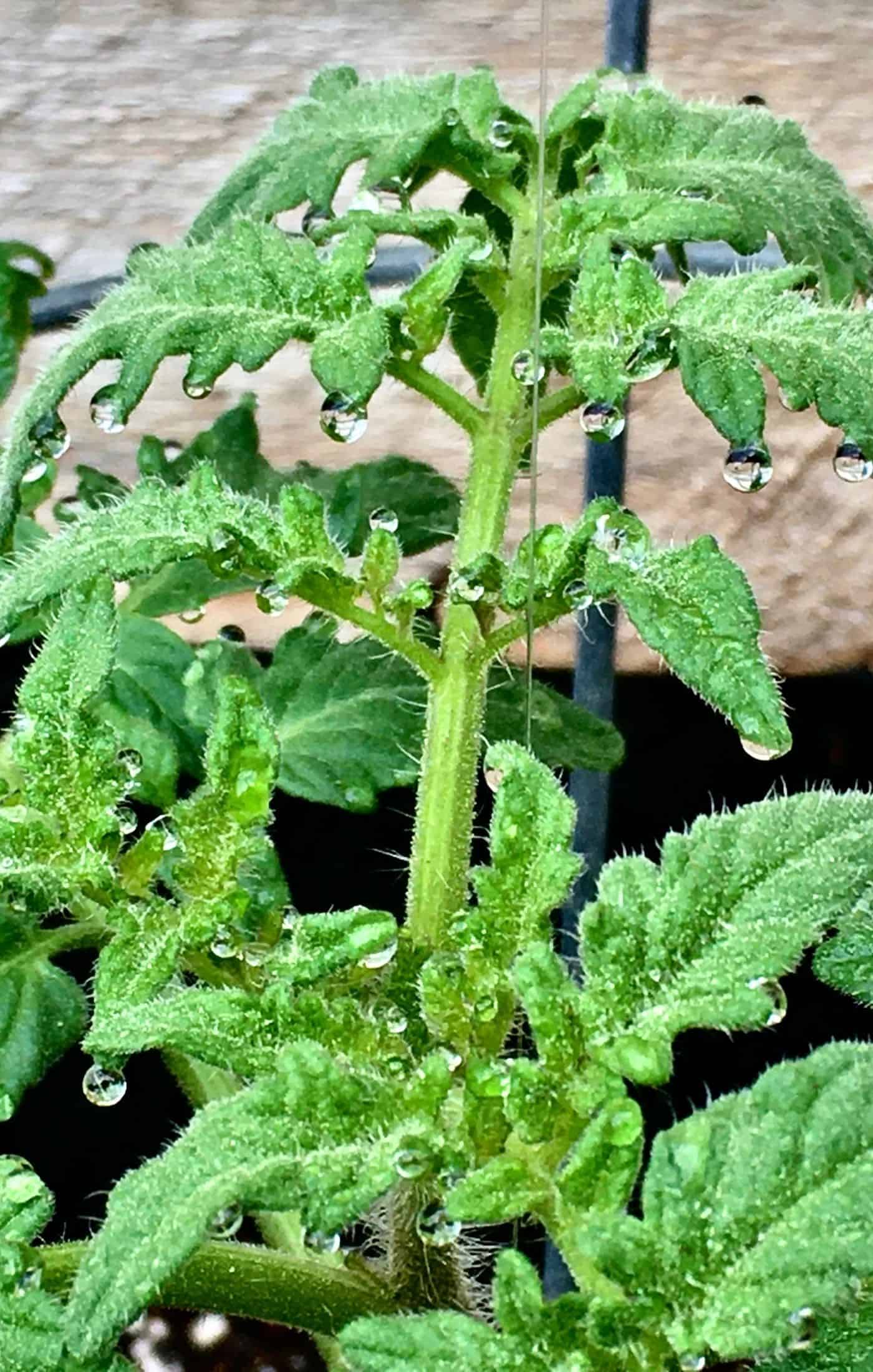
How to grow & care for Better Boy tomato plants?
Better Boy Tomato plants start as tiny seedlings but quickly grow to fill in a surface area of 24″ wide and 48″-60″ tall (or more if the tomato cage is taller).
Watering Better Boy tomato plants
Better Boy Tomato plants should be watered frequently and consistently so they can produce large yields. The easiest way to water them is with automated drip irrigation, but you can water them using any method that waters the soil around the base of the plant. Avoid getting water on the foliage of the plants.
Plants may only need watering once or twice a week in the spring or during rainy weather, but the plants will likely require watering every other day or even daily in very hot weather (especially if planted in a small container). The best time to water is early in the morning so that any moisture that gets on the plants has the opportunity to dry quickly during the heat of the day.
Irregular watering once the fruit has set can lead to the cracking of the developing tomato peels. Provide the plants with an even supply of moisture. Avoid sudden influxes of water such as heavy watering after missing watering for a few days, as this sudden burst of water can cause the tomatoes to swell and the peels to crack.
Weeding garden beds
Weed garden beds on a regular basis, typically once or twice per week. When weed seedlings are small, they are easy to rake out with a handheld cultivator or pluck out and toss in the compost heap. If allowed to grow larger, they become more difficult and disruptive to the tomato plants to pull out. If left for quite a while they may even go to seed and lead to a whole new generation of weeds in the garden.
Pruning tomato plants
Large tomato plants like Better Boy grown inside large, heavy-duty tomato cages typically do not need much pruning at all. If, however, your plants are growing up a tomato stake, they will likely require pruning of the suckers to keep the plants under control and prevent them from toppling over. When growing up a stake, one vine should be designated as the main stem and tied very gently to the stake at 1′ increments.
One area that is generally pruned on most tomato plants is the bottom of the stem. Once the plant has been in the ground for a month or two, the bottom leaves can become yellowed. Trim off the leaves from the base of the plant up to about 8″-10″ from the soil level. Keeping the base area relatively clear can help with air circulation and make the foliage less susceptible to foliar disease.
Fertilizing tomato plants
Tomato plants are typically fed throughout the growing season with either a slow-release granular tomato fertilizer or a water-soluble tomato fertilizer. The granular fertilizers typically last for a month or two while liquid formulations last only a couple of weeks. Be sure to follow the application instructions and frequency guidelines listed on the fertilizer of your choice. Here are some options for both types of tomato fertilizer:
Dry granular fertilizer
Additionally, avoid using fertilizers with high amounts of nitrogen like lawn fertilizer, evergreen fertilizer, and even some all-purpose fertilizer mixes. High amounts of nitrogen can lead to large tomato plants with lots of foliage but very few tomatoes. It can also occasionally exacerbate Blossom End Rot.
Protecting tomatoes from pests
As tomatoes ripen on the vine they become targets for pests and wildlife. This includes everything from slugs, snails, and ants to birds, rabbits, and even deer.
Slug and insect protection usually consists of either crushed eggshells or horticultural diatomaceous earth on the soil around the base of the plant, or beer traps if slugs are particularly bad. For flying insects, a protective row cover fabric works well. Row cover is easy to set up with garden bed hoops and insect netting fabric. If you see any tomato hornworms, remove them from the garden and destroy them.
If larger wildlife is a problem, there are more options. Both protective bird netting and deer fencing are easy to find in garden centers. You can also try to lure birds away from the garden by placing a bird feeder and birdbath away from the garden or even try your hand at making your own scarecrow.
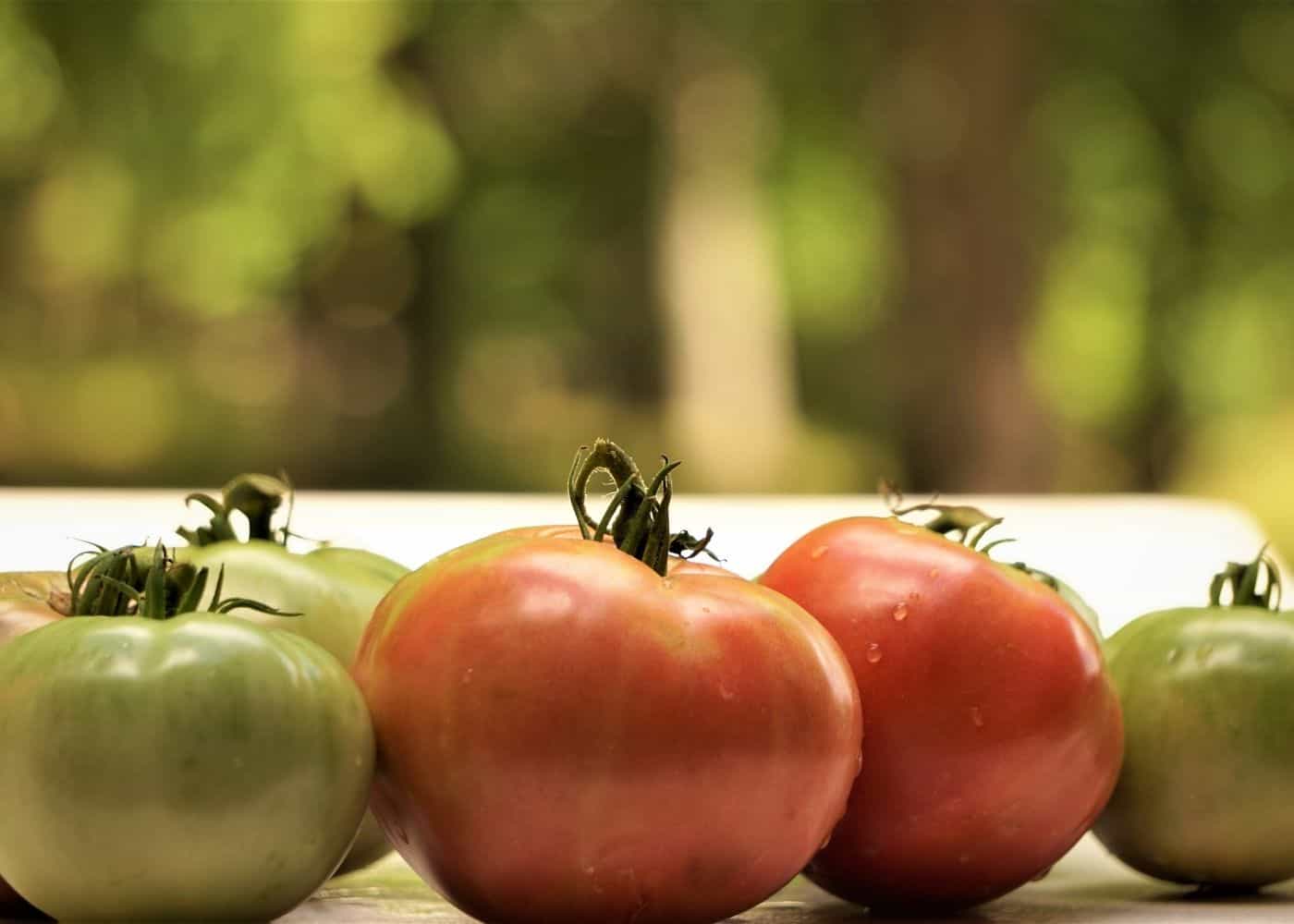
Harvesting ripe Better Boy tomatoes
Better Boy Tomatoes are best left on the vine to ripen. It typically takes ~72 days after the seedling was planted outdoors for the first tomato to ripen. Expect to wait anywhere from 70-75 days after planting the seedling before the first tomatoes are ready to pick. It may take longer if the seedling was planted out too early in the spring or if midsummer weather was extremely hot.
Better Boy Tomatoes are ripe when they have a rich red peel color and have just barely started to soften up. The tomatoes should still be quite firm but will have a bit of “give” when gently squeezed. Pick them in the morning and enjoy them as soon as possible!
Better Boy Tomatoes are indeterminate and will continue to set tomatoes through early fall until frost. Keep an eye on the weather forecast, as frost or freezing temperatures will kill the plant. If frost is forecasted, harvest all the green tomatoes on the plant. These green tomatoes will ripen indoors off the vine.
Storing Better Boy tomatoes
Better Boy Tomatoes can be stored for up to a month or two in a cool dry storage area. Choose only whole, undamaged tomatoes for storage. Any less-than-perfect tomatoes can be stored on the kitchen counter at room temperature out of direct sunlight for 2-3 days until ready for fresh use or processing into a cooked sauce or another recipe.
The most important part of tomato storage is to find a location that is not too cold but not too hot. Tomatoes store best between 55°-60°F (12°-16°C). Sometimes you can find a good spot in a basement or garage that naturally stays in this temperature range. Resist the urge to store the tomatoes in the fridge as the cold temperatures cause the flavor to deteriorate rapidly and the texture to become very mushy.
Storage tomatoes are generally wrapped in newspaper or placed in paper bags to ripen. The paper keeps the tomatoes from contacting each other, as this can cause early rot. It also helps to trap some ethylene gas that comes off the tomatoes naturally and keeps it nearby to encourage further ripening. Check the ripening tomatoes regularly and remove any that have signs of rot or mold.
Common pests affecting Better Boy tomato plants
Better Boy Tomatoes and other attractive ripening fruits in the garden can be very attractive to garden pests such as insects and larger wildlife. The protective netting covers described earlier in this article will deter most pests that affect home growers, but occasionally pests will sneak in to attack your tomato plants.
Aphids are a common garden pest that feeds on the plants as they suck the liquid out. These tiny colorful bugs cluster on stems and under leaves. They also drop sticky “honeydew” residue that attracts ants. The ants may even start farming the aphids for their honeydew. If you notice aphids, you can start by ordering some ladybugs and releasing them into the garden to act as natural predators. It can also be surprisingly easy to spray off the plants with a sharp stream of water.
If there are quite a few aphids, consider using an organic insecticide such as Insecticidal Soap, Neem Oil Spray, or a specialty product like Captain Jack’s Dead Bug Brew to eradicate the pests. Most organic sprays can be reapplied on a regular basis to ensure the eradication of pests.
Parasitic Nematodes are another common garden pest for tomatoes, especially in warm climates. These microscopic worms live in the soil and damage the roots, leading to wilted or stunted plants. Start by avoiding planting tomatoes at all in infected soil. Use grow bags or large containers filled with fresh potting mix. You can also plant ‘Nema-Gone’ Marigolds around the tomatoes as they have been proven to kill nematodes in the soil. Also, try planting a green manure cover crop during the off-season, and be sure to rotate garden beds each year.
Common diseases affecting Better Boy tomato plants
Tomato plants are unfortunately quite prone to disease in the garden. That said, the short lifespan of these plants means that diseases don’t need to be completely prevented as long as they can be delayed to the very end of the season. And fortunately, there are a variety of good organic gardening practices that naturally reduce the prevalence of the disease.
Anthracnose is a fungal disease that causes small depressions on ripening tomatoes which get larger and turn black, causing the fruit to be covered with rotten black spots. This fungus is most prevalent when summer weather has been hot and humid, or when the plants have been watered from above rather than at the soil base. To decrease the growth of this fungus, rotate crops annually, give tomato plants lots of space for good air circulation, prune off the bottom leaves, add mulch on the soil surface to reduce the splashing of water onto the leaves, and remove and discard any dead plant material from the garden as soon as it appears. Natural copper fungicide can also be applied as a preventative measure.
Early Blight is a fungal disease that causes brown rings on the leaves of the tomato plant, especially near the base. The leaves eventually turn brown and often drop off the plant. This disease causes the tomato growth to become stunted and the tomatoes won’t grow to their expected size. The tomatoes may even get dark spots and may rot on the plant. This is especially common in cool, wet weather. Avoid watering the plants overhead, give each plant lots of space, and trim any diseased leaves off immediately.
Septoria Leaf Spot is a fungal disease that causes black spots on the leaves of the tomato plant. As with other fungal diseases, it thrives in cool, wet weather and in gardens without adequate air circulation. It generally appears on the bottom leaves first. Treatment is the same as with other fungal diseases. Remove the infected leaves from the area, give plants lots of space, apply copper fungicide before planting, and rotate the plants each year.
Wilt diseases are fungal or bacterial diseases that cause the tomato plant to wilt with little warning. This is caused by harmful soil-borne bacteria or fungi that attack the roots. Fusarium wilt and Verticillium wilt are of particular concern. Rotate plants, give plants lots of space, apply copper fungicide, and remove/destroy infected plant debris immediately.
Blossom End Rot is a condition where the bottom of each tomato turns brown/black and the fruit rots before it ripens. Blossom End Rot is caused when the plant cannot absorb enough calcium. Once a fruit shows signs of blossom end rot, it won’t recover and must be discarded. To prevent end rot on future tomatoes, start by applying a liquid tomato fertilizer rich in calcium (see above for recommendations) or some garden lime. The end rot may also be caused by damaged roots or stress on the plant, even if there is enough calcium in the soil. Be sure to water and fertilize plants regularly throughout the season.
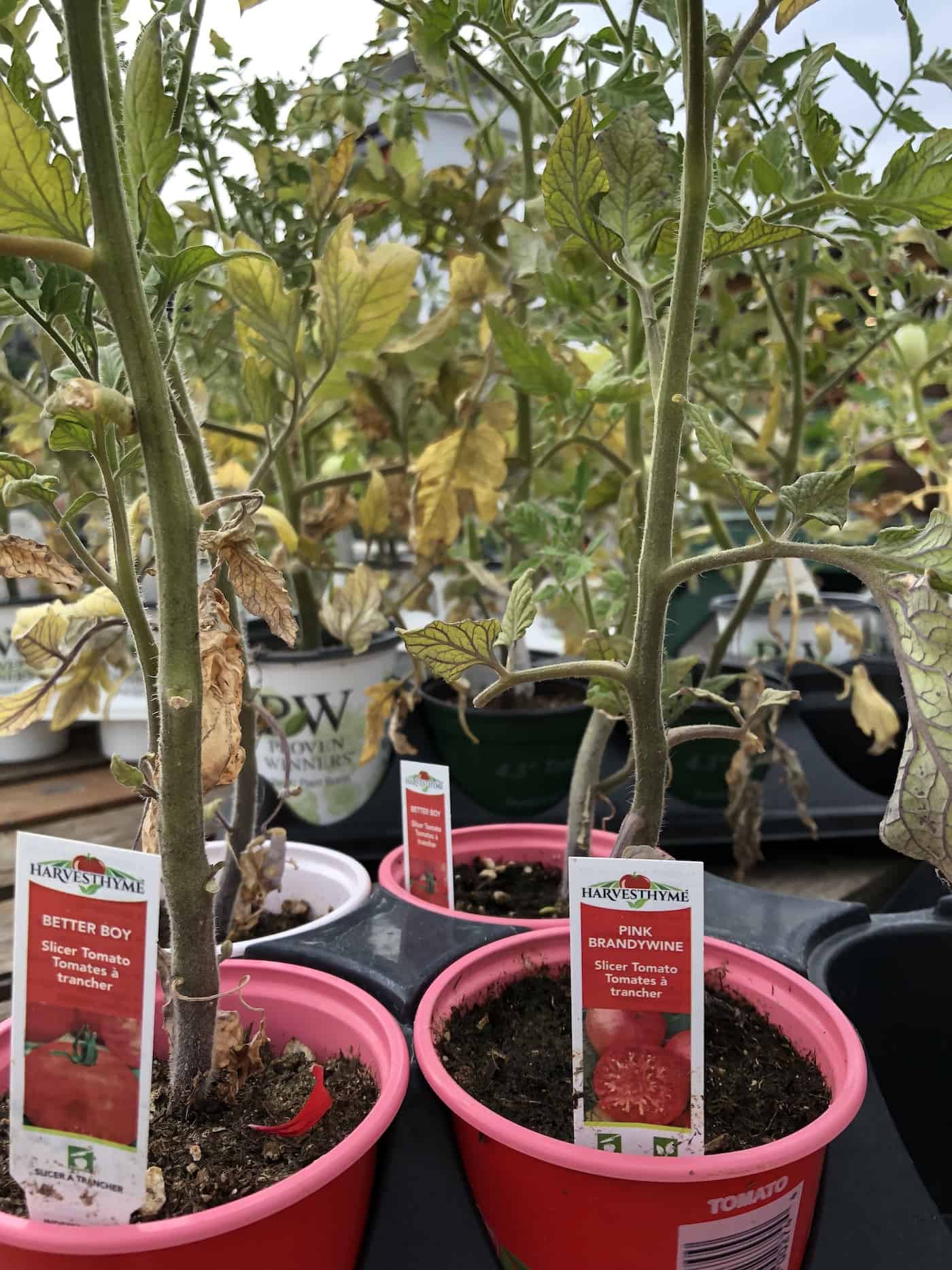
Are Better Boy tomatoes heirloom tomatoes?
Better Boy Tomatoes are not heirloom tomatoes. They are not heirlooms because they are grown from hybrid seed, not the open-pollinated seed. Secondly, they were bred in the 1960s. True heirloom tomatoes are considered to be bred, discovered, or introduced prior to 1950. If you’d like a similar variety to Better Boy that’s an heirloom, consider Mortage Lifter, Beefsteak, or Brandywine.
How tall do Better Boy tomato plants get?
Better Boy plants can get quite tall – about 6 feet inside a large tomato cage – over the growing season. The indeterminate vines continue to grow longer and longer until killed by frost or removed with pruners. Vines are generally 4-6 feet tall when staked vertically, but can grow up to 10 feet or taller if a support structure like a tall cage is provided and growing conditions are good. Be sure to use a tomato cage or a tomato stake to support your plant.
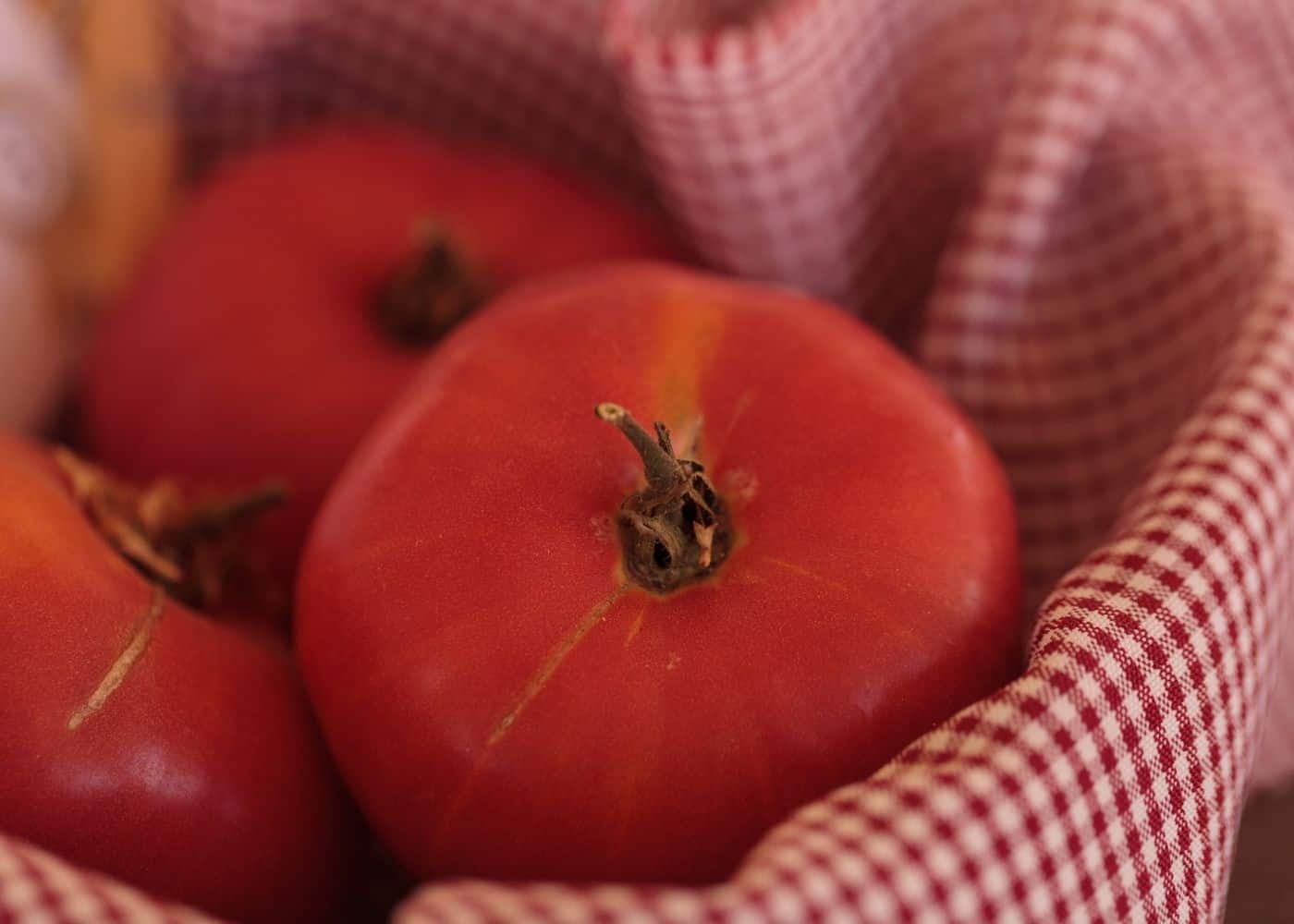
Better Boy tomato recipes
Better Boy and other larger slicer tomatoes are delicious raw in a salad or sandwich, and can also be added to cooked recipes such as grilled veggies, stews, casseroles, and sauces. They can also be canned, frozen, or dried for future use.
Here are some recipes that are well-suited to Better Boy Tomatoes:
- Grilled Ratatouille Pasta Salad on Epicurious
- Fresh Tomato Sandwiches from The NY Times
- Buttered Tomatoes with Ginger & Soy Sauce on Epicurious
- Caprese Tomato Burger on All Recipes
Resources
- How To Grow Tomatoes For Beginner Gardeners
- Better Boy Seedling Tomato Plant
- Better Boy Tomato Seeds from Burpee
- Recommended Fertilizer For Growing Tremendous Tomatoes
- My Favorite Tools For The Vegetable Garden
- Growing Heirloom Tomatoes, with Marie Iannotti (Online Course on Craftsy)


